Victorian Closing the Gap Partnership Forum and Partnership Agreement
In alignment with the National Agreement on Closing the Gap (National Agreement), the Victorian Government established a new Partnership Forum on Closing the Gap (Partnership Forum) in 2022.
The Partnership Forum is intended to be the formal mechanism for decision making on Closing the Gap implementation. It is made up of Ngaweeyan Maar-oo and senior departmental executives, and the heads of all departments and key agencies in the Victorian Public Sector.
The Partnership Agreement outlines the agreed arrangements for the formal partnership between the parties of Closing the Gap Partnership Forum (Partnership Forum) across all targets and priority reform areas as outlined in the National Agreement on Closing the Gap.
This Agreement acknowledges that real and sustained impacts are made through advancing First Peoples’ self-determination. This Agreement focuses on advancing First Peoples’ self-determination through empowering Aboriginal Community Controlled Sector partners, promoting accountability of Victorian Government departments and mainstream service providers, and breaking down systemic barriers faced by First Peoples.
Through Victoria’s Implementation Plan, the partnership will drive progress on the National Agreement’s four Priority Reforms with a view to achieving and exceeding the National Agreement’s socioeconomic targets and outcomes. The Victoria government will continue to transform the way it works with ACCO sector to ensure First Peoples are respected to make decision about their own lives.
Victorian Aboriginal Implementation Plan
Victoria’s implementation plan on closing the gap (implementation plan) outlines the actions Victoria will undertake to achieve the objectives of the new national agreement on closing the gap.
The Victorian Implementation Plan was developed in close partnership with the Victorian government, former Aboriginal Executive Council, other key Aboriginal partnership forums and Aboriginal community-controlled organisations (collectively referred throughout this plan to as Victoria’s Implementation Partners). While the Victorian Implementation plan was originally planned to run for the first three years of the National Agreement (2020 to 2023), the Victorian government extended its term to 30 June 2025.
As Victoria’s implementation partner, Ngaweeyan Maar-oo helps influence actions and decisions aimed at applying the National Agreement on Closing the Gap in the Victorian Implementation Plan.
Victorian Affairs Governance Report
Each year, the Victorian Government Aboriginal Affairs Report (VGAAR) provides an opportunity to track the progress of our commitment to improving outcomes for Aboriginal Victorians as measured against the Victorian Aboriginal Affairs Framework. It is also an important opportunity to recognise the achievements and strengths of Victorian Aboriginal communities.
The previous reports show that while progress has been made in some areas we must renew our effort across all areas in order to keep working towards genuine equality for Aboriginal Victorians.
The National Agreement
What is the National Agreement?
The national Close the Gap campaign begun following the release of the Social Justice Report 2005 by then Social Justice Commissioner Tom Calma AO, which detailed the ‘Indigenous Health Challenge’. A key recommendation from the Report called for all Australian governments to commit to ‘achieving equality of health status and life expectancy between Aboriginal and Torres Strait Islander and other Australians within a generation’.
In 2008, the Council of Australian Governments (COAG) committed to Closing the Gap on Indigenous Disadvantage as part of the then National Indigenous Reform Agreement (NIRA). Closing the Gap targets were developed to reduce the inequality of health outcomes between Aboriginal and Torres Strait Islander people and other Australians. Progress on the targets was hindered over time by incomplete implementation, insufficient government investment, and inadequate engagement and collaboration with Aboriginal people and Community involvement.
In 2018, the Coalition of Australian Governments (COAG) agreed to establish the Joint Council for Closing the Gap, strengthening the commitments of the formal Partnership on Closing the Gap between Aboriginal and Torres Strait Islander peoples and the Australian Government.
The National Agreement on Closing the Gap (National Agreement) was co-designed by the Coalition of Aboriginal and Torres Strait Islander Peak Organisations (Coalition of Peaks) and the Australian government and aims to enhance government collaboration with Aboriginal people. The signing of the National Agreement on 27 July 2020 by all Australian governments and the Coalition of Peaks further strengthened the commitment to a new way of working, to achieve what previous agreements could not.
The National Agreement is structured around four priority reform areas and 17 socio-economic outcome areas, with clear commitments to develop implementation plans, supported by a range of accountability and oversight measures for shared monitoring and implementation tracking.
Coalition of Peaks
The Coalition of Peaks (CoP) comprises over 50 Aboriginal and Torres Strait Islander community-controlled peak and member organisations across Australia who came together to change how Australian governments work with our people. As a community-controlled organisation, the CoP works for and is accountable to our communities, not governments. The CoP share a belief that Aboriginal and Torres Strait Islander people should have a meaningful say on policies and programs that impact us through formal partnerships with Australian governments at all levels.
Ngaweeyan Maar-oo is a member of and the jurisdictional peak body for Victoria on the Coalition of Peaks, with which it shares and from which it seeks information.
Joint Council
The Joint Council on Closing the Gap was formed by the Council of Australian Governments (COAG) as a key part of its commitment to a formal Partnership on Closing the Gap with Aboriginal and Torres Strait Islander peoples.
The Partnership acknowledges the critical role of involving Aboriginal and Torres Strait Islander peoples in the shared decision-making process concerning the design, implementation and performance of the National Agreement on Closing the Gap aimed at improving the life outcomes for Aboriginal and Torres Strait Islander peoples.
For the first time, Aboriginal and Torres Strait Islander representatives are included as joint decision-makers alongside other stakeholders in supporting national leadership, coordinating and cooperating on Closing the Gap, and providing advice to Australian governments.
Members are to meet a minimum of twice a year to discuss matters that support the strategic priorities of the Joint Council, address urgent matters requiring attention and align with the 2024 Joint Council Workplan.
Learn more about the Joint Council on Closing the Gap and view all communiques outlining all discussions, actions and decisions being made at all meetings.
What are the Priority Reforms?
The four priority reform areas are central to achieving the systemic and structural transformation of how governments work with Aboriginal and Torres Strait Islander people.
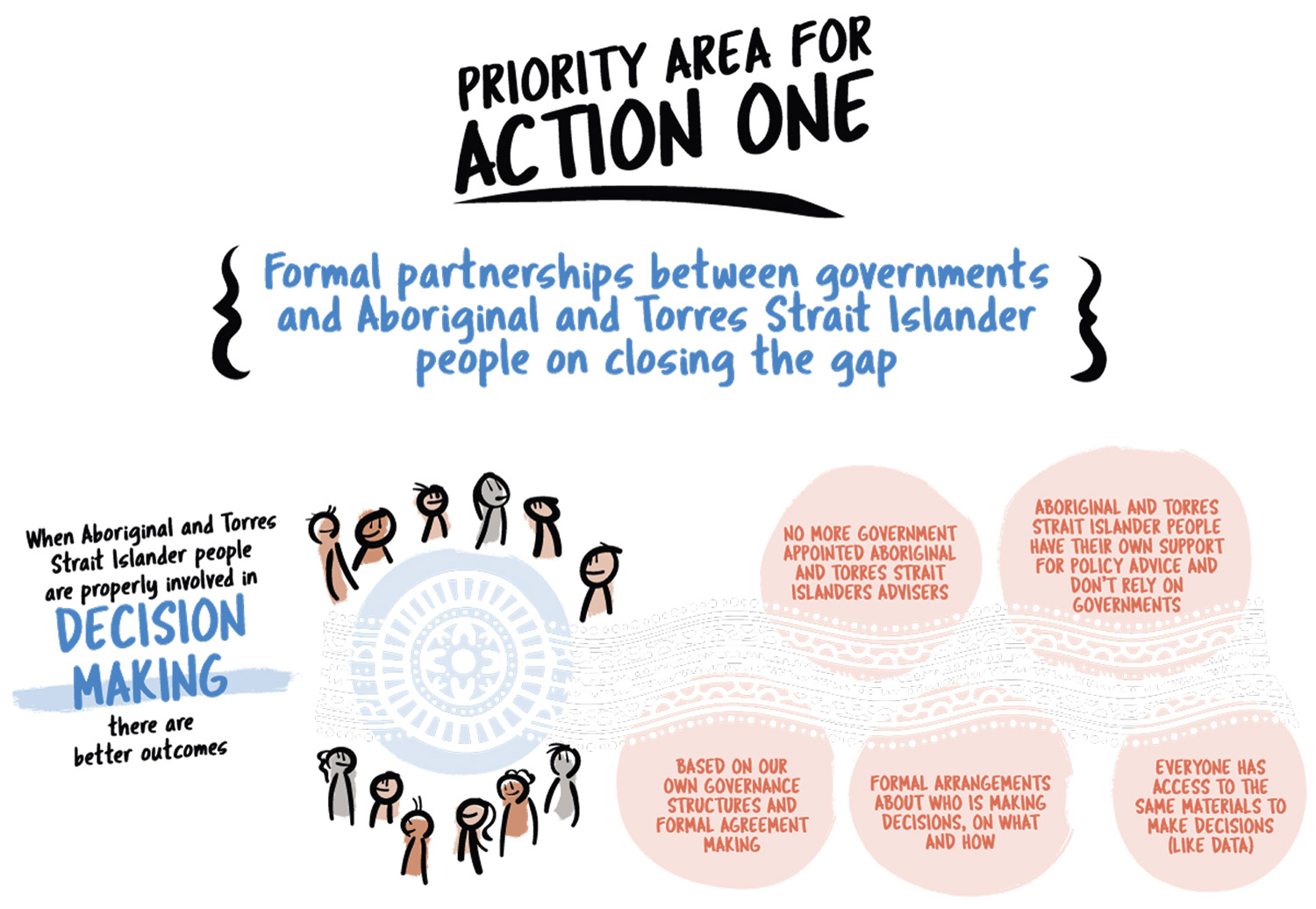
Priority Reform 1:
Formal partnerships and shared decision-making
There will be formal partnership arrangements to support Closing the Gap in place between Aboriginal and Torres Strait Islander people and governments in place in each state and territory enshrining agreed joint decision-making roles and responsibilities and where Aboriginal and Torres Strait Islander people have chosen their own representatives.
Outcome
Shared decision-making: Aboriginal and Torres Strait Islander people are empowered to share decision-making authority with governments to accelerate policy and place-based progress on Closing the Gap through formal partnership arrangements.
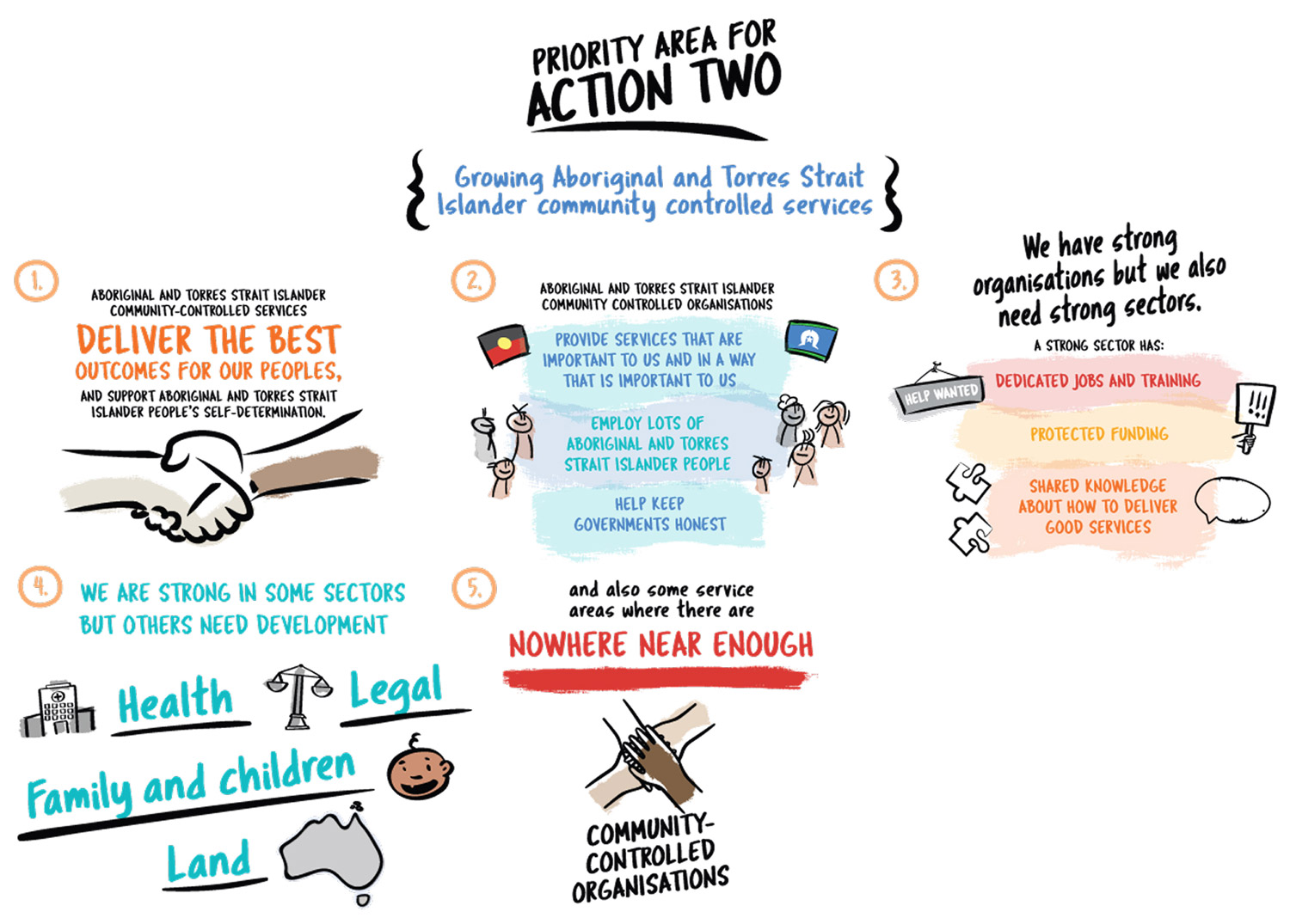
Priority Reform 2:
Building the community-controlled sector
Increase the amount of government funding for Aboriginal and Torres Strait Islander programs and services going through Aboriginal and Torres Strait Islander community-controlled organisations.
Outcome
Building the community-controlled sector: There is a strong and sustainable Aboriginal and Torres Strait Islander community-controlled sector delivering high-quality services to meet the needs of Aboriginal and Torres Strait Islander people across the country.
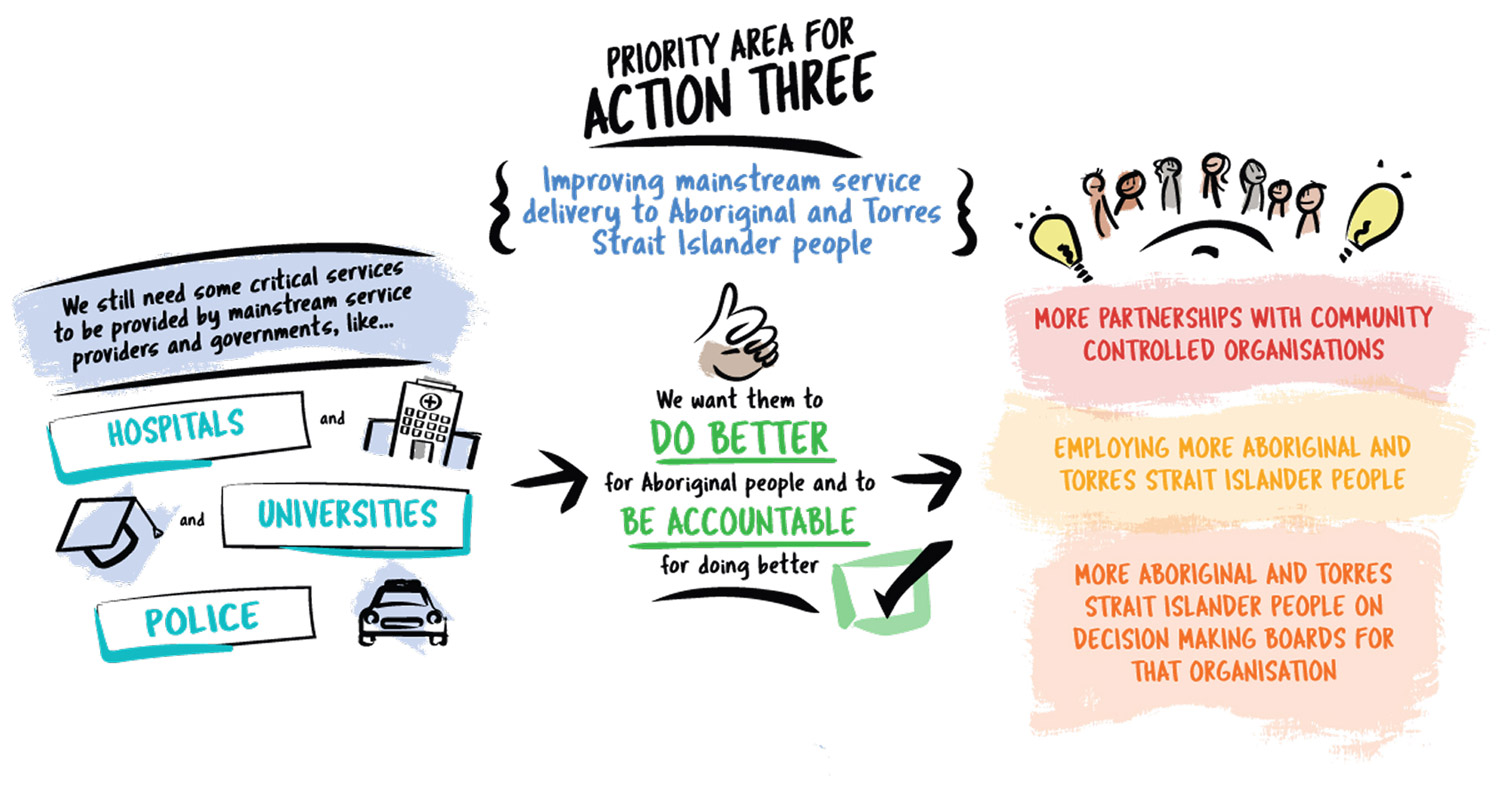
Priority Reform 3:
Transforming government organisations
Decrease the proportion of Aboriginal and Torres Strait Islander people who have experiences of racism.
Outcome
Improving mainstream institutions: Governments, their organisations, and their institutions are accountable for Closing the Gap and are culturally safe and responsive to the needs of Aboriginal and Torres Strait Islander people, including through the services they fund.
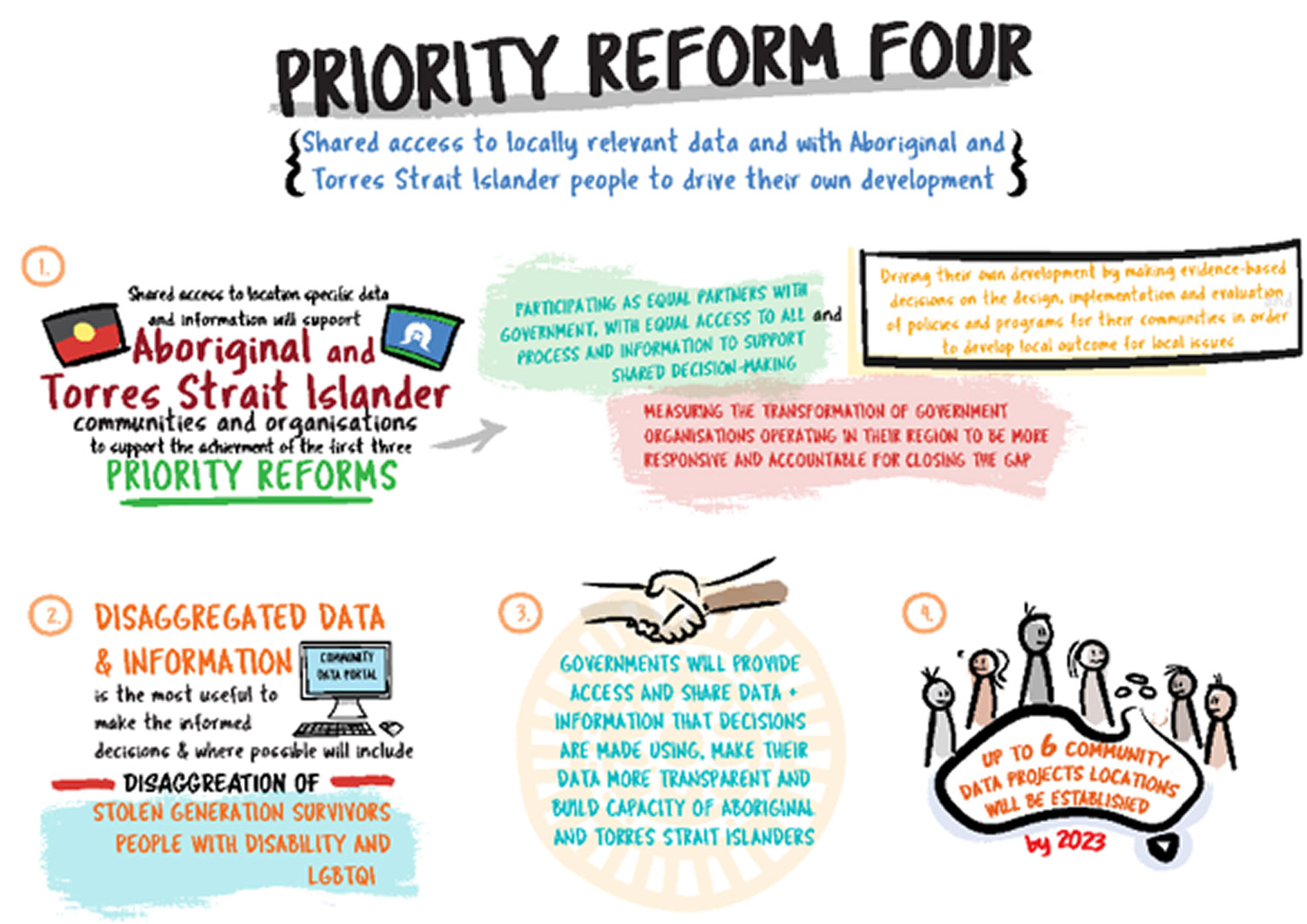
Priority Reform 4:
Shared access to data and information at a regional level
Increase the number of regional data projects to support Aboriginal and Torres Strait Islander communities to make decisions about Closing the Gap and their development.
Outcome
Aboriginal and Torres Strait Islander people have access to, and the capability to use, locally relevant data and information to set and monitor the implementation of efforts to close the gap, their priorities and drive their own development.
Learn more on how Ngaweeyan Maar-oo’s work is driving the work of the four Priority Reforms.
What are the Targets and Outcomes?
To ensure parties are achieving the objectives and intended outcomes of the National Agreements, targets are established and reported on annually by governments.
The National Agreement on Closing the Gap has 19 socio-economic targets across 17 socio-economic outcome areas.
The outcome areas capture the desired result for Aboriginal and Torres Strait Islander people, whilst the targets are the specific goals that governments are publicly accountable for and are used to measure progress against the outcomes. These socio-economic targets focus on life outcomes for Aboriginal and Torres Strait Islander people including education, employment, health and well-being, justice, safety, housing, land and waters and Aboriginal and Torres Strait Islander languages.
Using the data from the Productivity Commission Dashboard that tracks and monitors the progress against the targets, the outcomes and their corresponding targets are as follows:
The outcomes and their corresponding targets are as follows:
Good improvement and on track
Worsening
No change from baseline
No assessment available
Health and Wellbeing
Outcome
Aboriginal and Torres Strait Islander people enjoy long and healthy lives.
Target
Close the gap in life expectancy within a generation by 2031.
Outcome
Aboriginal and Torres Strait Islander children are born healthy and strong.
Target
Increase the proportion of Aboriginal and Torres Strait Islander babies with a healthy birthweight to 91 per cent by 2031.
Outcome
Aboriginal and Torres Strait Islander children thrive in their early years.
Target
Increase the proportion of children assessed as developmentally on track in all five domains of the Australian Early Development Census to 55 per cent by 2031.
Outcome
Aboriginal and Torres Strait Islander children are not overrepresented in the child protection system.
Target
Reduce the rate of over-representation of Aboriginal and Torres Strait Islander children in out-of-home care by 45 per cent by 2031.
Outcome
Aboriginal and Torres Strait Islander people enjoy high levels of social and emotional well-being.
Target
Significant and sustained reduction in suicide of Aboriginal and Torres Strait Islander people towards zero.
Education and Employment
Outcome
Aboriginal and Torres Strait Islander children are engaged in high-quality, culturally appropriate early childhood education in their early years.
Target
Increase the proportion of children enrolled in Year Before Fulltime Schooling early childhood education to 95 per cent by 2025.
Outcome
Aboriginal and Torres Strait Islander students achieve their full learning potential.
Target
Increase the proportion of people aged 20-24 years attaining year 12 or equivalent qualification to 96 per cent by 2031.
Outcome
Aboriginal and Torres Strait Islander students reach their full potential through further education pathways.
Target
Increase the proportion of people aged 25-34 years who have completed a tertiary qualification (Certificate III and above) to 70 per cent by 2031.
Outcome
Aboriginal and Torres Strait Islander youth are engaged in employment or education.
Target
Increase the proportion of youth (aged 15-24 years) who are in employment, education or training to 67 per cent by 2031.
Outcome
Strong economic participation and develop of Aboriginal and Torres Strait Islander peoples and communities.
Target
Increase the proportion of people aged 25-64 years who are employed to 62 per cent by 2031.
Justice
Outcome
Aboriginal and Torres Strait Islander peoples are not overrepresented in the criminal justice system.
Target
Reduce the rate of adults held in incarceration by at least 15 per cent by 2031.
Outcome
Aboriginal and Torres Strait Islander young peoples are not overrepresented in the criminal justice system.
Target
Reduce the rate of young people (aged 10-17 years) in detention by 30 per cent by 2031.
Safety
Outcome
Aboriginal and Torres Strait Islander familiar and households are safe.
Target
Reduce the rate of all forms of family violence and abuse against Aboriginal and Torres Strait Islander women and children by at least 50 per cent by 2031, as progress towards zero.
Housing
Outcome
Aboriginal and Torres Strait Islander peoples secure appropriate, affordable housing that is aligned with their priorities and need.
Target
Increase the proportion of people living in appropriately sized (not overcrowded) housing to 88 per cent by 2031. And By 2031, all Aboriginal and Torres Strait Islander households.
Land and Waters
Outcome
Aboriginal and Torres Strait Islander people maintain a distinctive cultural, spiritual, physical and economic relationship with their land and waters.
Target
- By 2030, a 15 per cent increase in Australia’s landmass subject to Aboriginal and Torres Strait Islander people’s legal rights or interests.
- By 2030, a 15 per cent increase in areas covered by Aboriginal and Torres Strait Islander peoples’ legal rights or interest in the sea.
Languages
Outcome
Aboriginal and Torres Strait Islander cultures and languages are strong, supported and flourishing.
Target
There is a sustained increase in number and strength of Aboriginal and Torres Strait Islander languages being spoken by 2031.
Digital Inclusion
Outcome
Aboriginal and Torres Strait Islander peoples have access to information and services enabling participation in informed decision-making regarding their own lives.
Target
Aboriginal and Torres Strait Islander people to have equal levels of digital inclusion by 2026.
